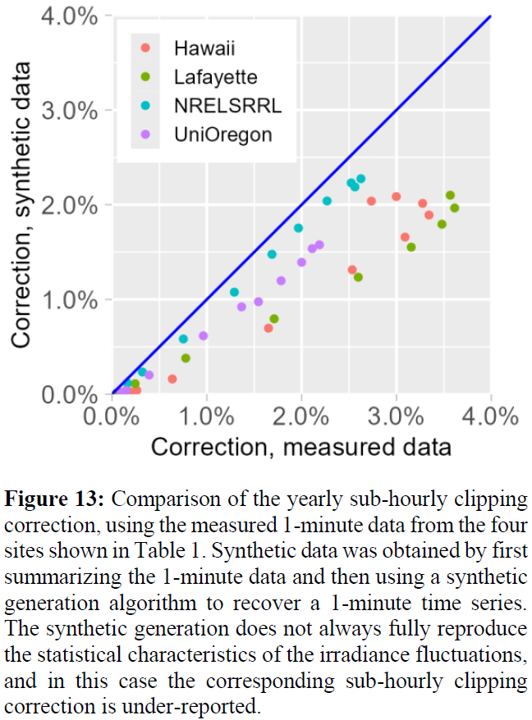
kjs55
Members-
Posts
156 -
Joined
-
Last visited
Recent Profile Visitors
The recent visitors block is disabled and is not being shown to other users.
-
PVsyst v6: Inconsistent Date Format in Hourly Output .CSV File
kjs55 replied to kjs55's topic in Problems / Bugs
None of the methods proposed thus far in this thread work for me over the entire PVsyst date column. You can see the problem if you open the PVsyst output CSV file in Excel and add a new column with the formula =DAY(PVsyst_date) and drag it down. The root problem is that the PVsyst output date column contains mixed data types/formats (both serial numbers and text strings). Here is what I finally found to work for the default PVsyst output date format "DD/MM/YY; Hour; (Excel)": year =IF(ISNUMBER(PVsyst_date+0),YEAR(INT(PVsyst_date+0)),1900+VALUE(MID(TRIM(PVsyst_date),7,2))) month =IF(ISNUMBER(PVsyst_date+0),DAY(INT(PVsyst_date+0)),VALUE(MID(TRIM(PVsyst_date),4,2))) day =IF(ISNUMBER(PVsyst_date+0),MONTH(INT(PVsyst_date+0)),VALUE(LEFT(TRIM(PVsyst_date),2))) hour =IF(ISNUMBER(PVsyst_date+0),QUOTIENT(ROUND(MOD(PVsyst_date+0,1)*1440,0),60),VALUE(MID(TRIM(PVsyst_date),10,2))) minute =IF(ISNUMBER(PVsyst_date+0),MOD(ROUND(MOD(PVsyst_date+0,1)*1440,0),60),VALUE(RIGHT(TRIM(PVsyst_date),2))) second =IF(ISNUMBER(PVsyst_date+0),MOD(ROUND(MOD(PVsyst_date+0,1)*86400,0),60),0) xlsdatenum =DATE(year,month,day) + TIME(hour,minute,second) -
I'm getting a 404 Error for URL: <https://www.pvsyst.com/old-versions/> (i.e., the link for downloading past versions of PVsyst) Thanks.
-
@Linda Thoren Scientific literature (e.g., Clean Power Research CPR, UL, Townsend, PVsyst, several others) indicates that synthetic 1-min. satellite data exhibit only ~60% of natural radiation's variability as compared to ground-based data, thus defeating the purpose of performing subhourly corrections. For example, below I include an excerpt from a PVsyst publication on this point [1]. Furthermore, it remains unclear how to then accurately use subhourly correction results derived from a 1-min. dataset, obtained via PVsyst V8, together with the ultimate hourly, typical meteorological year TMY dataset employed ubiquitously in the simulation used for project finance. Thank you. 4.3 Synthetic data The correction model relies on sub-hourly data, ideally 1-minute data, or at least a sampling frequency that matches the variations in power of the DC array. Arguably the most reliable source for high frequency data are ground measurements. However, in practice, it can be difficult to obtain this data, especially during preliminary design phases for the PV system. One possibility is to rely on a synthetic generation procedure. This type of approach allows to generate sub-hourly fluctuations from a lower sampling frequency input. For example, one can use typical statistics for sub-hourly data to complement satellite data, which is found generally in 15-minute time steps. The result of this procedure is a high frequency time series that matches the original measurements up to a certain time scale (e.g. 15 minutes for satellite data). We refer the reader to [8], e.g., for a more thorough discussion on this subject. Since the clipping correction can utilize any sub-hourly time series, as a proof of concept, we use here the hourly averages for the data obtained from Table 1 and utilize such a synthetic procedure to generate a 1-minute time series. The results are summarized in Figure 13, compared against those from Figure 11, where the original time series was used. From these preliminary results we can extrapolate that the synthetic generation methodologies may induce further biases. Indeed, in the example we have studied, the clipping correction extracted from the synthetic data is lower for all four sites and for all DC:AC ratios. <see attached image> Figure 13: Comparison of the yearly sub-hourly clipping correction, using the measured 1-minute data from the four sites shown in Table 1. Synthetic data was obtained by first summarizing the 1-minute data and then using a synthetic generation algorithm to recover a 1-minute time series. The synthetic generation does not always fully reproduce the statistical characteristics of the irradiance fluctuations, and in this case the corresponding sub-hourly clipping correction is under-reported. [1] M. Oliosi, B. Wittmer, A. Mermoud, A. Bridel-Bertomeu, and R. Vincent, “Implementation of a Sub-Hourly Clipping Correction in PVsyst.” WIP-Munich, 2024. doi: 10.4229/EUPVSEC2024/4DV.4.7.
-
Bumping this again.
-
I have the same question as LauraH.
-
PVsyst V8.0.12: Hello, the "Operating losses at STC" sections of the PVsyst V8 output PDF report have disappeared (!). See below screenshots as example (V8 screenshot is missing the section; V7 screenshot contains the section on the right-hand side). (NB: Please note the value for Iron Loss Fraction in one of the screenshots is incorrect, as there was a typo in the input. This rapid example was for screenshot purposes only.)
-
There are common instances when we would apply different "soiling" assumptions (which includes dust, snow, etc.) for different PV module types (e.g., monofacial, bifacial). We would like the ability to apply a different set of monthly soiling values for each subarray in PVsyst V8. This would resemble the subarray dropdown menu for the MQA factor in Detailed Losses. Is it on the development roadmap? Thanks.
-
Hi, I'd like to specifically request a 10-min. editing time as an incremental (and meaningful) improvement. Thank you!
-
PVsyst V8 Problem Statement: How to apply spectral adjustments to certain subarrays (containing certain PV module cell types) and *not* to others? Ideas (example only): 1.) This could be handled in the PV module PAN file, through a checkbox which (if checked) will apply spectral adjustments IF the tab in Detailed Losses is applied 2.) This could be handled as a dropdown menu for each subarray on the spectral adjustment tab in Detailed Losses, similar to the MQA factor subarray dropdown menu, where you can toggle on/off spectral adjustments for each subarray 3.) (Least favorite option): If the spectral adjustment tab of Detailed Losses is applied, it could automatically apply spectral adjustments onto the specific technologies involved in each subarray according to PV cell technology type. This is the least favorite option, because not all PV cell technologies should use spectral adjustments (e.g., single-junction Si-based technologies). Conversely (and preferably), Options 1 and 2 above would allow the user to *only* apply spectral adjustments onto the (sub)set of PV cell technologies in the applicable subarrays which require spectral adjustments. Thank you!
-
Here's one way CCC could be incorporated into PVsyst, to enable more accurate modeling with standard hourly TMY datasets:
-
Let's imagine you have a 100 MWdc PV system with: - Split Si PV module design using half-cut PV cells in Orientation #1 with split partitioning, and - CdTe PV module design in Orientation #2 with no split partitioning How do you assign: - "according to module strings" with 100% "fraction for electrical effect" for Orientation #1, and - "linear shadings" for Orientation #2 ? Please advise. Thanks.





